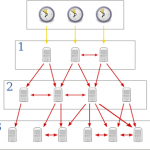Time synchronization is a crucial aspect of computer networking. Ensuring all machines on a network are synchronised to the global timescale, UTC (Coordinated Universal Time), otherwise time sensitive transactions with other networks would be impossible.
Time synchronization is made easy thanks to the Network Time Protocol (NTP) which was devised in the early days of the Internet for that very purpose. It works be utilising a single time source (usually UTC) which is then distributed amongst all devices on the NTP network.
The UTC time source is often taken from the Internet on networks where security is not a great issue but as this involves leaving an open port in a network firewall for many networks the vulnerability this can leave isn’t worth the risk.
Dedicated network time servers (often referred to as NTP servers) are used by many networks as a secure and even more accurate method of receiving UTC. These devices receive the UTC time direct from an atomic clock source.
Furthermore, these dedicated time servers operate external to the firewall and network and use sources such as GPS or radio frequencies to pick up the time codes.
For ease of synchronisation there are various time synchronisation software packages that run hand-in-hand with NTP and allow, through browser interfaces, easy configuration of the time synchronization throughout the network.
Whilst these time synchronisation software packages aren’t essential in using most NTP servers, the standard software installed in operating systems is often lacking or quite complicated.
Most specialist producers of dedicated network time servers will produce a times service client to allow configuration and these are probably best suited for the device from that suppler. However, there are many freeware and open source time synchronisation software packages that are mostly compatible with many NTP servers.



